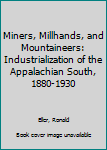Miners, Millhands, and Mountaineers: Industrialization of the Appalachian South, 1880-1930
Select Format
Select Condition 
Book Overview
An examination of the social and economic history of the Appalachian South from 1880 to 1930, describing the revolutionary changes in mountain life as the region was swept up in the American drive... This description may be from another edition of this product.
Format:Hardcover
Language:English
ISBN:087049340X
ISBN13:9780870493409
Release Date:January 1982
Publisher:University of Tennessee Press
Length:272 Pages
Weight:0.45 lbs.
Customer Reviews
3 ratings
Miners, Millhands, and Mountaineers: Industrialization of the Appalachian South, 1880-1930
Published by Thriftbooks.com User , 14 years ago
Ronald Eller shows extensive research into the history of how the cultural, economic, and industrial landscapes of southern appalachia was changed through the demands of its renewable and non-renewable natural resources. This book is highly recommended to individuals who are both anxious and curious to strengthen their knowledge about the exploitation of labor and natural resources in southern appalachia.
Why Appalachia industrialized, but failed to modernize.
Published by Thriftbooks.com User , 17 years ago
Mention "Appalachia" today and the idea of a "backward" people in an impoverished region left behind by progress comes to mind. When it was published in 1982, Ronald D. Eller's Miners, Millhands, and Mountaineers: Industrialization of the Appalachian South, 1880-1930, was the first study to argue that, contrary to this common perception, modernization had not passed the region by. Until Eller's no other scholarly study had address the industrialization of Appalachia. What Eller discovered was that Appalachia had indeed passed through a dynamic period of transformation but that as a result "the mountaineers had lost the independence and self-determination of their ancestors, without becoming full participants in the benefits of the modern work." (242) What remained after the boom years was a society trying to cling to tradition but unable to afford the trappings of modern life. Profits generated from the extraction of timber and coal had flowed into the coffers of outside investors. It is Eller's thesis that while Appalachia had undergone industrialization, the region failed to modernize. He argues that in order to understand the reasons, Southern Appalachia's industrialization should be viewed in a national context. Profits came from the extraction of mountain resources at the lowest possible cost for national markets. This view is buttressed by Gavin Wright's (1996) economic interpretation of the South as a low wage economy within a larger economy. Eller agrees with this interpretation. Like Wright, he argues industrialization was accomplished with cheap labor. Eller's treatise spans the years 1880 to 1930. Prior to 1880 the area's remoteness and inaccessibility had delayed development. In chapter one, "On the Eve of a Remarkable Development," Eller paints an idyllic Jeffersonian agrarian scene of pre-industrial life in the mountains. Isolated by geography, "the mountain landscape favored the establishment of five forms of settlement - gap, cove, hollow, ridge, and meadow communities - but cove and hollow settlements predominated throughout the region."(8) The topography limited communication and transportation. Subsistence farming was the order and what agrarian economy existed was limited. "By 1880, Appalachia contained a greater concentration of noncommercial family farms than any other area of the nation."(16) A distinct mountain culture shaped communities and people were self sufficient and independent. It was a patriarchal society where families depended on each other and kinship relationships determined social, religious and political order.(30) Urban centers were few and, except for the villages and towns, society was ordered according to status rather than class. Respectability was valued within the community. Unfortunately the idyllic life that Eller describes was on the threshold of destruction. Two forces were directed toward Appalachia. One, capitalistic, was aimed at the riches of the land, and the other, intellectual, t
Ellers monumental text
Published by Thriftbooks.com User , 18 years ago
This text was one of the first books to explore the industrialization of Appalachia. It set the field for much of the current discouse that is being developed in Appalachian History. It is very well written and provides a good list of sources for additional study.





